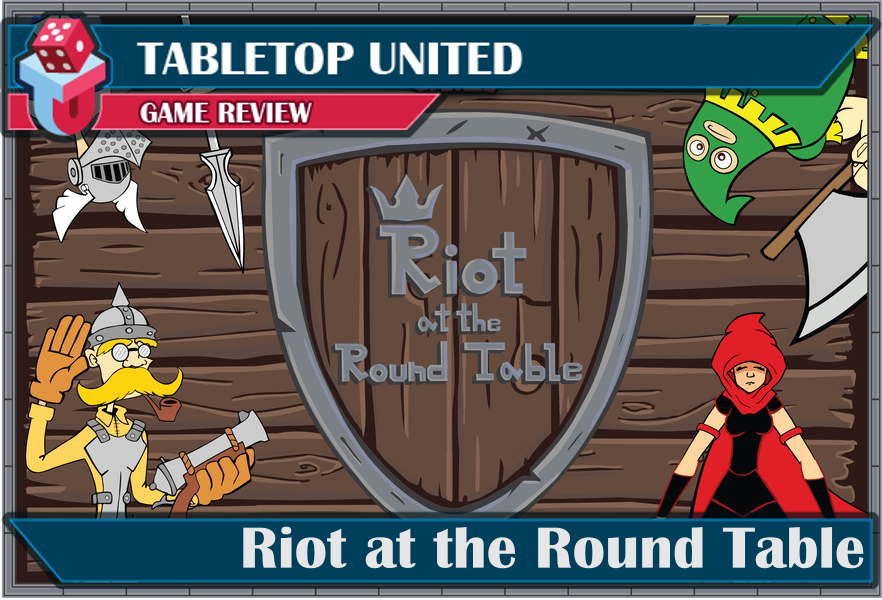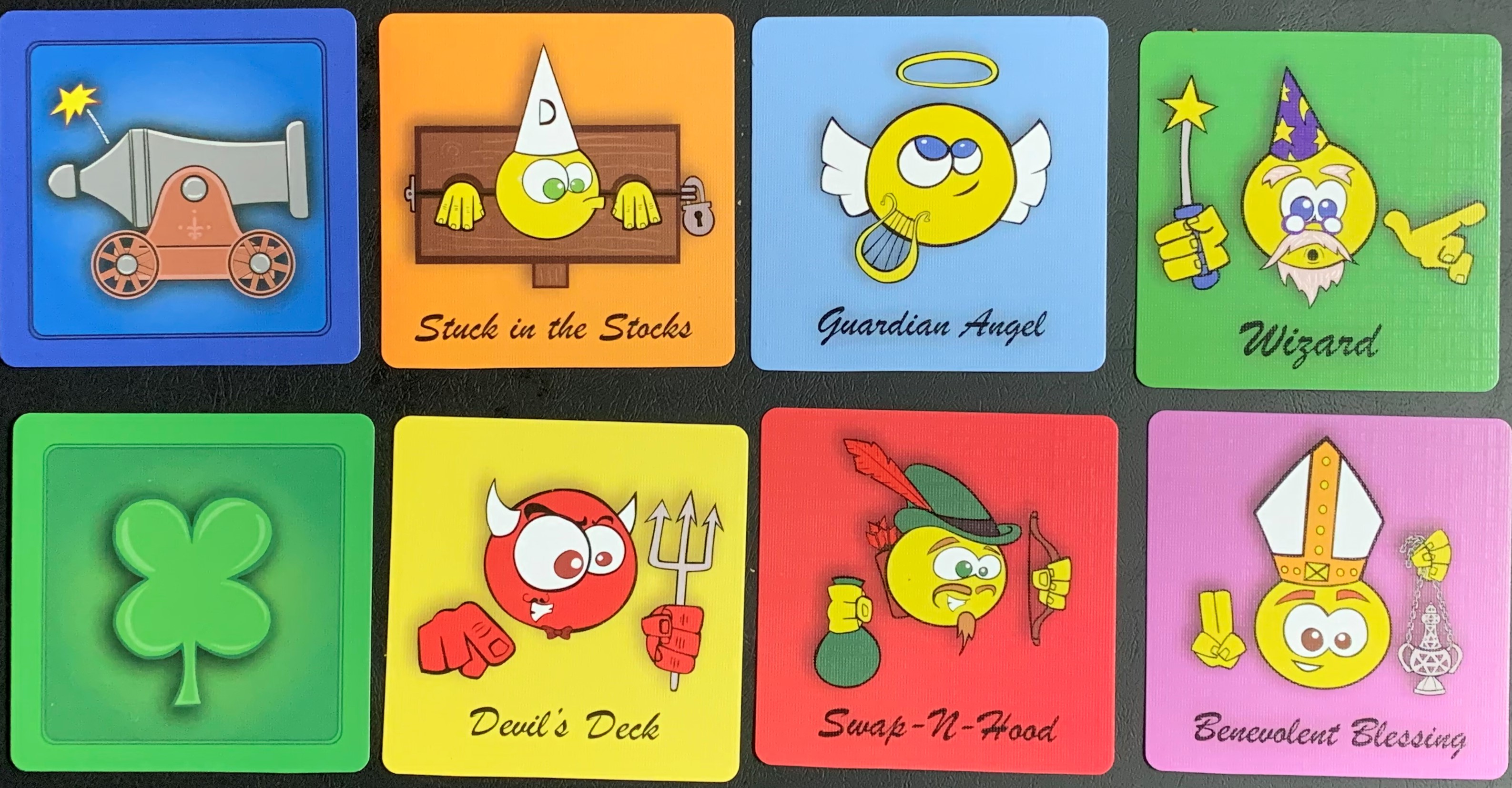
Riot at the Round Table
Designer: Johnathan Casper and Jessica Casper
Artist: Johnathan Casper
Publisher: Imp Powered Games
Year Published: 2020
No. of Players: 2–6
Ages: 14+
Playing Time: 45–60 minutes
Main mechanic / Theme: Hand Management and Attack / Medieval (King Arthur’s Court)
Do you have what it takes to rule Camelot?
Find more info on BoardGameGeek.com
Overview:
I was given a copy of Riot at the Round Table by one of the developers at the SaltCon End of Summer Event. I had the opportunity of playing it while it was still being play tested at SaltCon in a previous year.
If you are familiar with the Russian card game Durak, you may have an advantage of knowing how Riot at the Round Table plays. I didn’t know what Durak was like, so I decided to look it up to see how it compares. Riot at the Round Table uses the basics and then expands to create its own fast-paced game. The rules are easy to understand, but there is a lot more strategy involved when the game gets underway.
The goal is to earn three crowns and become the new king. A crown is earned by being the first player to discard all of their cards as a round ends. Other players earn a scepter or a clover, which has use or can be traded up as the game progresses. The multiple rounds give players the opportunity of catching up and altering their strategy if they need to prolong the game to an additional round.
There are several different card decks used in Riot at the Round Table. There is the deck used to make the player’s hands and provides the draw pile. These consist of four classes (colors) that mostly reflect a standard deck of playing cards with a few alterations. There are also Arsenal Cards that can be used during game play. The Arsenal Cards are played during the game to alter the situation.
The draw deck contains three Reroll Cards that may change the Ruling Class during play. More on that soon.

Gameplay and Mechanisms:
Each player is dealt a hand of six cards from the deck without the Reroll Cards. The Reroll Cards are then added to the draw deck and the deck is reshuffled.
The Ruler of the Realm is determined, and they will initiate the first attack. They also roll the Die of Power to find out the current riling class, or trump suit. The player to their left is given the Defense Token and will need to decide how they defend against the attack.
Attack Phase
The initial attacker (the player to the right of the defender, plays at least one card from their hand in front of the defender. If they play more than one card, they must all be of the same value but can be of different classes (suits). Jesters are wild cards that match and value or played as the attack with a value of one.
The rest of the non-defending players can now add to the attack. This is also done with only matching values.
Defense Phase
The defending player has three options: forfeit, pass, or defend.
Forfeit is when the defender either cannot defend against the attack or decides they don’t want to defend against the attack. When the player forfeits the combat, they add the attack cards to their hand.
Pass is when the player has a card of matching value, and they decide to pass the attack to the player to their left. This action is not an option if the number of cards attacking is greater than the number of cards in the next player’s hand. When this action is taken, the player passes the Defense Token and the attacking cards to the next player.
Defend is when the player decides to fight the battle. The defender must now play a card to defend against each of the attacks made against them. This is done by playing a card of higher value within the same class, a jester, or a card from the ruling class if the attack card is not of the ruling class. Ruling class cards must be defended by higher cards from the ruling class or a jester.
Here is where play can get a little wild. Once a defending player announces they are defending and start laying down cards, all the attacking players can add to the attack. This happens all at the same time. The new attacks must either match the value of the initial attack or the value of one of the defending cards. Jesters now take on the value of the highest card in play.
The Defense Phase ends with different results depending on the action taken by the defender and whether they were able to defend against the attack.
If the defender Forfeits the attack, they add the attack cards to their hand, drawing takes place, and the Defense Token is passed. However, the forfeiting player doesn’t get to initiate the next attack.
If the attack is passed, the player receiving the attack has the same decision of whether they will forfeit, pass, or defend.
When a player fails a defense, they add all of cards in play into their hand and players draw. The defense token moves two to the left and the failed defenders doesn’t get to initiate the next attack.
When the player successfully defends, all the cards in play are moved to the dead pile and players draw. The successful defender draws a Cannon Card. The Defense Token moves one to the left and the successful defender will initiate the next attack.
Draw Phase
Players with less than six cards draw their hands back up to six. This continues until the draw pile is depleted, which starts the End Round.
During the Draw Phase, if a player draws a Reroll Card, they reroll the Die of Power to possibly change the ruling class. They continue to draw until they have six cards in their hand.
End of Round
When the draw pile has been depleted, play continues as normal for two more times around the table. The first player to play their last card down wins the round. This earns them a Crown Card. The player with the most cards left in their hand at the end earns a Clover Card. The rest of the players earn a Scepter Card.
Shuffle up the deck and start a new round unless a player has earned three crowns by winning rounds or trading up Clover or Scepter Cards.

Theme, Artwork and Illustration, Graphic Design and Layout
The light-hearted aspects of the art played off well as a good counterpoint to the level of strategy. The attack/defense phase of the game can become intense as everyone is watching to see if they can, and want to, play a card as part of the attack.

Inclusivity and Accessibility:
Riot at the Round Table is a card game that requires quick decision making and strategy planning. People who may struggle handling cards may find it harder to play, but not impossible.
The game was developed by a husband-and-wife team.
What Worked:
The rules include variants. This provides more options on how to play. These include rules for two-player and team play. You can also make the game longer or shorter by adjusting the number of crowns needed to win.

Final Thoughts:
The strategy in Riot at the Round Table is in the decisions being made on when to play cards and which action to take when defending. If you are concerned about getting passed on, then you might want to hold back on the attack. If the attack contains cards you think will help you later, you might want to forfeit. You might want to dominate the attack making it impossible for the defender to pass. You might want to throw down a Clover or Cannon to change things up. There are a lot of options within the simple set of rules.
Once battle is joined, Riot at the Round Table becomes an appropriate title. The battle can quickly escalate or suddenly end. Play slowed at other times, allowing players to talk and provide banter back and forth. This change of pace during play worked well in providing intense times and relaxed times.
I recommend Riot at the Round Table for players who like card game strategies with an additional twist provided by having extra cards added into a standard deck. Due to the complex decision making and how the action can move to a quick intense play, I don’t think many younger players would enjoy playing.

About the Author
Daniel Yocom does geeky things at night because his day job won't let him. This dates back to the 1960s through games, books, movies, and stranger things better shared in small groups. He's written hundreds of articles about these topics for his own blog, other websites, and magazines after extensive research along with short stories. His research includes attending conventions, sharing on panels and presentations, and road-tripping with his wife. Join him at guildmastergaming.com.

